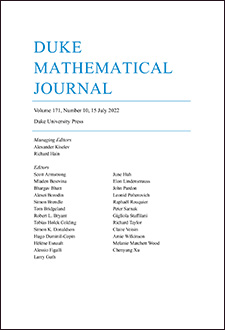Abstract
Consider the Hopf–Cole solution of the Kandar–Parisi–Zhang (KPZ) equation with the narrow wedge initial condition. Regarding as a scaling parameter, we provide the first rigorous proof of the large deviation principle (LDP) for the lower tail of , with speed and an explicit rate function . This result confirms existing physics predictions made by Corwin (2011); Sasorov, Meerson, and Prolhac (2017); and Krajenbrink, Le Doussal, and Prolhac (2018). Our analysis utilizes a formula from Borodin and Gorin (2016) to convert the LDP for the KPZ equation to calculating an exponential moment of the Airy point process (PP). To estimate this exponential moment, we invoke the stochastic Airy operator (SAO) and use the Riccati transform, comparison techniques, and certain variational characterizations of the relevant functional.
Citation
Li-Cheng Tsai. "Exact lower-tail large deviations of the KPZ equation." Duke Math. J. 171 (9) 1879 - 1922, 15 June 2022. https://doi.org/10.1215/00127094-2022-0008
Information





